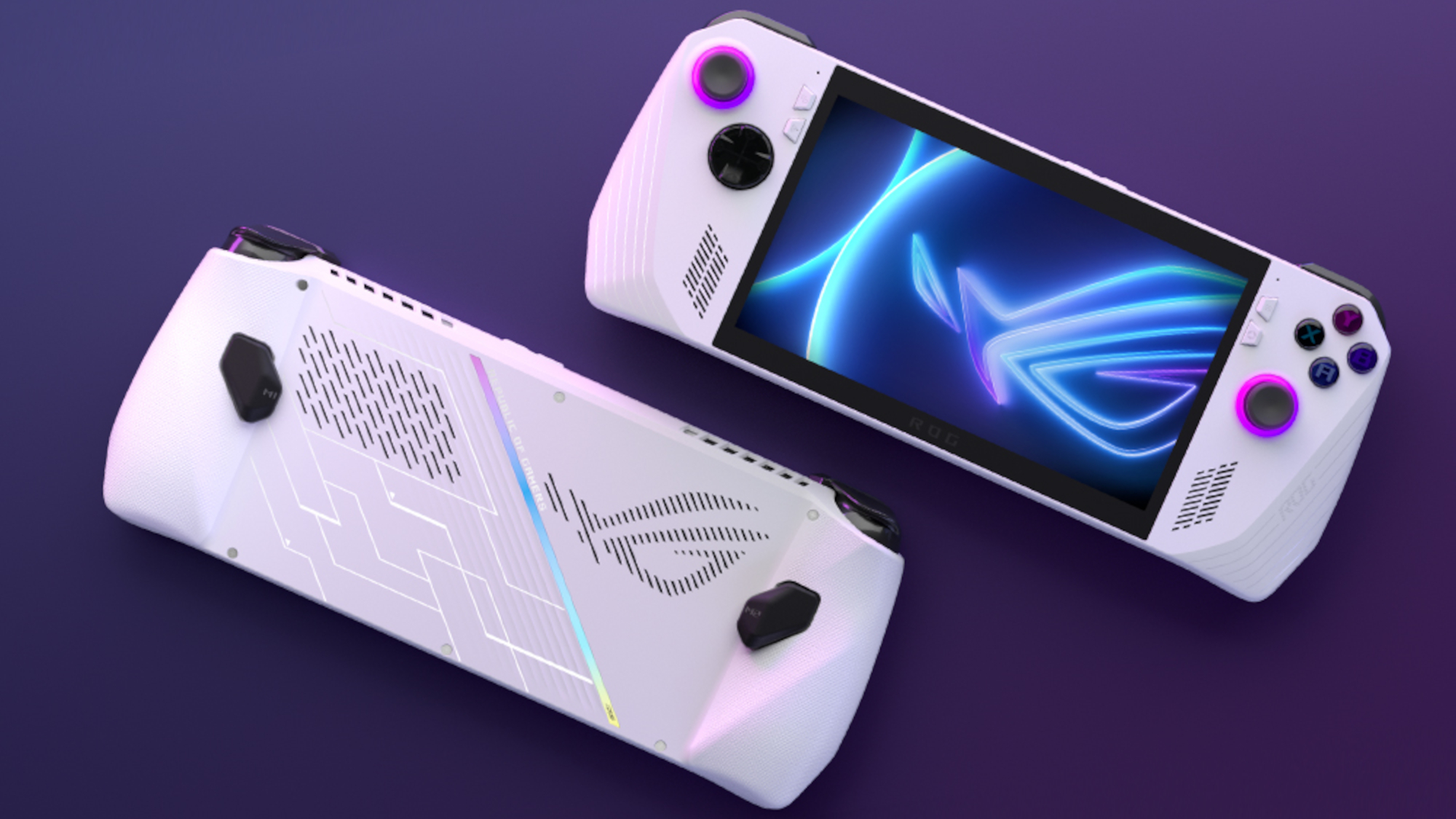
The Asus ROG Ally could be a legitimate rival to the Steam Deck, given what we know so far about Asus' portable PC gaming machine.
The upcoming Windows 11 handheld boasts better specs than Valve’s Deck, including a 1080p 120Hz display and a customized AMD Ryzen chip Asus claims is the fastest AMD APU yet. If these claims hold water, the ROG Ally could be the next must-have gaming handheld.
There are still many lingering questions about the ROG Ally, including its price, release date and exact specs. We’ve gathered all we know about Asus’ handheld to see how it stacks up against the Steam Deck.
Asus ROG Ally vs Steam Deck: Price
The big question is: how much will the ROG Ally cost? According to YouTuber Dave2D who went hands-on with the Ally, Asus says its handheld will be “competitively priced.” However, we don’t know if that’s in comparison to the Steam Deck or to other high-end handhelds on the market.
The highest-end Steam Deck with 512GB of storage costs $649. Competitors like the GDP Win 4 and AyaNeo 2 are more powerful than the Steam Deck but cost more as well, hovering around the $1,000 mark.
If the ROG Ally is comparable to these machines it may have a similar price tag, but that remains to be seen. However, it’s possible the Ally might cost as much as the high-end Steam Deck. As Digital Trends reports, the Ally reportedly costs between $650 to $700 according to a supposed leaked image posted on Twitter.
Asus ROG Ally vs Steam Deck: Design
The ROG Ally has a similar design to the Nintendo Switch and Steam Deck. Like those handhelds, it has two analog sticks, a d-pad and four face buttons. There are two buttons on the back — which is two fewer than the Steam Steck but twice as many as the Switch has no back buttons.

According to Dave2D, the ROG Ally measures 11.0 x 4.4 x 0.5 inches and weighs 1.3 pounds. In contrast, the Steam Deck measures 11.73 x 4.60 x 1.93 inches and weighs 1.5 pounds. Overall, Asus' handheld is smaller and weighs less than the Steam Deck.
It’s too early to tell how the ROG Ally feels when you’re playing but by the sounds of things, it should be as comfortable to use as a Switch or Steam Deck.
Asus ROG Ally vs Steam Deck: Display
The ROG Ally has a 7-inch display 120Hz 16:9 display with a resolution of 1920 x 1080. Asus says it can hit 500 nits of brightness. The Steam Deck also has a 7-inch display, but it has a maximum resolution of 1280 x 800 and a 60Hz refresh rate. Valve says the Steam Deck can hit 400 nits of brightness but it peaked at 170 nits of brightness in our lab test.
The display is one area where the ROG Ally may have an advantage over the Steam Deck. Games don't look bad on Steam Deck, however. As I said in my review, games look phenomenal on the Steam Deck’s 7-inch LCD touchscreen and the 16:10 aspect ratio works well when navigating through the SteamOS interface. However, games should look and run better on a 1080p 120Hz display.
You could argue that some may not notice a difference between 720p and 1080p on a 7-inch display, but you will likely feel a difference between 60 and 120Hz. Again, we’d need to go hands-on with the ROG Ally to see if its display delivers a better visual gaming experience. But at least on paper, Asus’ machine seems to have the edge. However, a higher resolution screen and faster refresh rate could negatively impact battery life.
Asus ROG Ally vs Steam Deck: Performance
According to what Asus told Dave2D, the ROG Ally supposedly has double the performance of the Steam Deck. The company told Linus Tech Tips, who also previewed the system, that the Ally is twice as fast as the Steam Deck at 35 watts — with the latter topping out at 15W. As Digital Trends notes, the Ally might not hit 35W at launch but it would place the APU in AMD’s U-series chips which go between 15W and 28W. This should result in better performance.
The aforementioned AMD chip powering the handheld is a custom Zen 4 RDNA3 4nm APU. The Steam Deck also uses an AMD APU, but its CPU is based on Zen 2 architecture while the GPU uses RDNA 2. This chip has four Zen 2 cores and eight RDNA 2 compute units. Right now, we don’t know how many of each the ROG Ally’s APU will have, but it should presumably be more, if we were to hazard a guess.
One of ROG Ally’s potential secret weapons is the ability to connect to the ROG XG Mobile, which is an external GPU that’s compatible with the company’s Flow laptops. Powered by an RTX 4090 laptop GPU, the XG Mobile could give the ROG Ally a serious performance boost. In addition, the device has a slew of ports — which is great considering the handheld only seems to have a single USB-C port.
However, the mobile GPU’s steep $1,999 asking price will no doubt be a major barrier to entry for many people.
Asus ROG Ally vs Steam Deck: Battery life
The ROG Ally uses the same ROG Intelligent Cooling technology utilized by Asus’ laptops. This could presumably give the Ally a long-lasting battery life, though it’s too early to say whether or not it will surpass the competition.
The Steam Deck and Nintendo Switch can last between two to seven hours, depending on what you’re playing. If this handheld can deliver a consistent five to six hours, that should make most customers happy — especially if they’re able to play graphically-demanding games for that long.
Dave2D said that he barely heard the ROG Ally's fans, even when he ran graphically-demanding games. According to his testing, the Steam Deck's fans reach 37 decibels on load while the ROG Ally reaches 20 decibels. The difference you can hear in the YouTube video is rather remarkable.
Given how the ROG Ally has a higher resolution display with a faster refresh rate and that it supposedly has double the performance, it’s battery life might not be better than the Steam Deck's. But we’ll see if the machine’s cooling technology can help it last for a decent amount of time.
Asus ROG Ally vs Steam Deck: Windows 11 vs SteamOS
Steam Deck runs on SteamOS 3.0, which is based on the Arch Linux distribution with a KDE Plasma 5 desktop. The OS supports Proton, which is a compatibility layer that lets Microsoft Windows-developed games run on the Linux-based SteamOS. All of that means Steam Deck can run a slew of games, although not all titles are compatible or optimized for the handheld.

Instead of a UI similar to Steam’s Big Picture mode, Steam Deck uses a modified version of the Steam desktop client that works well with a controller input. If you’re familiar with Steam’s interface then you’ll have little trouble navigating through its menus and sub-menus. You can access your game library, the Steam store, your friends list, downloads and settings. Though it’s not perfect, this interface works well most of the time.
The ROG Ally is a Windows 11 handheld and should allow you to install a variety of applications and programs. You should be able to run the desktop version of Steam, Xbox Game Pass, and other gaming clients. This should give you a greater degree of control over the games and applications you can install to the ROG Ally right out of the box. This is also possible on Steam Deck (you can run Windows 11 on it), but it takes some effort even if you’re tech-savvy.
The choice between Windows 11 and SteamOS will ultimately come down to preference. If you prefer a more streamlined handheld experience with the option for further customization, SteamOS is the winner. However, if you want everything Windows 11 provides out of the box, then the ROG Ally might be more to your liking.
Asus ROG Ally vs Steam Deck: Bottom line
Comparing the Asus ROG Ally against the Steam Deck is tricky since we’ve yet to test Asus’ handheld for ourselves. But given what we know, it has a lot going for it. Not only does it look stylish, but its specs should give it an edge over the Steam Deck. With the right price and a long battery life, it could be a winner.
Though there’s no shortage of systems vying for Steam Deck’s spot, the ROG Ally is worth keeping an eye on. After all, it’s manufactured by Asus which knows a thing or two about high-end gaming. That experience could be enough to give us an exceptional handheld. But we’ll know for certain when the ROG Ally releases. Hopefully, that time isn’t too far away.







